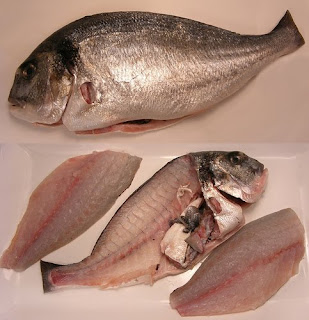Aquaculture Efficiencies

It is estimated that in the near future (some put the date at 2050) our oceans will no longer be able to support the growing seafood demand. In order to keep pace with demand fish farming (aquaculture) production is sure to increase. Now despite all the bad publicity that fish like farmed salmon receive, there are aquaculture operations that are on the cutting edge of sustainability. One in particular is Kona Blue Water Farms, where they raise Kona Kamapchi (Seriola rivoliana) a fish that would be known as Almaco Jack or kahala in the wild. I recently read a report they released that shows that the feed efficiency for farmed fish may in fact surpass wild fish. While the jury is still out because the report is subjective, I applaud the effort. Kona Blue is indeed doing the right thing and have received a lot of attention for the high level of stewardship they exhibit. What follows is the press release.
Kona Kampachi® - 60 Times Less Impact on Stocks than Wild-Caught Fish
Sustainable Aquaculture Can Meet Growing Demand Amid Depleted Fish Stocks
KAILUA-KONA, Hawaii —Kona Blue Water Farms released an analysis that demonstrates sustainably maricultured fish actually have 60 times less ecological footprint on the ocean than wild-caught fish. Kona Blue’s analysis supports the recent recommendation from the UN Food and Agriculture Organization (FAO) that called for an increase in fish farming amid falling wild populations and increasing fisheries closures, such as west coast rockfish, Gulf grouper, and the impending restrictions on red snapper.
“If we examine the true environmental cost of wild-caught predatory fish -- such as swordfish or tuna -- we find sustainably maricultured fish have some 60 times less impact on fish stocks at the base of the food chain, such as sardines and anchovies,” said Neil Anthony Sims, President of Kona Blue. The leading offshore mariculture operation in the U.S., Kona Blue raises sashimi-grade Kona Kampachi®, a Hawaiian yellowtail, off the coast of Hawaii.
“What would ocean-conscious consumers rather have on their plates?” asked Sims. “One pound of Kona Kampachi®, or one sixtieth of a pound of tuna? The impact on the oceans is about the same.”
Sims bases this estimate on three primary considerations. First, aquaculture is continually moving towards sustainable substitutes in farmed fish diets to lessen reliance on fishmeal and fish oil. Kona Blue’s current feed formulation includes only 35% fishmeal/fish oil from wild baitfish, of which approximately 3% is from capture fishery by-product. Contrary to outdated ratios of 5:1 or higher quoted by some environmental groups, the current ratio of “wild fish in to farmed fish out” has fallen to approximately 1.5:1 (1.5 lbs. of anchovies producing 1 lb. of sashimi-grade farmed fish).
By contrast, wild fish are subject to the laws of trophic transfer, where only 10% of their prey’s food value is transferred up each step of the food chain. “If a tuna eats a mackerel that earlier ate an anchovy, then there are two trophic steps, compounding the costs,” said Sims. “A tuna may therefore need to eat the equivalent of 100 pounds of baitfish to increase its weight by one pound.” As the fishmeal/fish oil for farmed fish feed involves only one efficient step, trophic transfer loss is minimized.
Secondly, Sims points out that farmed fish have a life cycle that is estimated to be three to ten times more efficient than wild predatory fish, since they are harvested at a young age, after their most efficient growth, and do not expend energy reproducing or competing to survive in the wild.
The last consideration is by-catch, or those unwanted fish caught by commercial fisheries that are discarded as unsaleable, undersized, or over quota. Some fisheries generate up to eleven pounds of by-catch for every pound that is retained. Experts estimate that almost 30% of the global wild harvest is discarded. Farmed fish have no by-catch, as only fish in the pens are harvested, and the schools of baitfish that go into fish feed rarely have any extraneous “take.”
“With these considerations,” said Sims, “we’ve estimated that one pound of our farmed Kona Kampachi® requires an environmental input of close to one pound of anchovies. A one pound serving of wild-caught tuna, however, would require around 60 pounds of baitfish.”
Sims asserted that responsible open ocean mariculture is a key solution to the depletion of ocean resources, but cautioned, “We still need to ensure rational, effective management of baitfish resources, and take into account ecosystem impacts.”
The entire analysis can be downloaded at
http://kona-blue.com/download/pr_ecologicalefficiencies.pdf.
Photo courtesy Kona Blue Water Farms.


Comments
Thanks for the information!